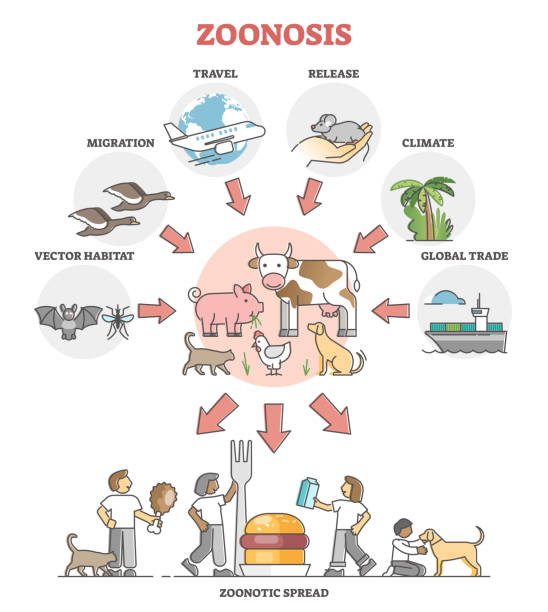For as long as humans have lived on Earth, the world of animals has remained intricately connected with our own. From the domestication of animals to our reliance on wildlife for food, medicine, and other resources, humans have always been in close contact with the animal kingdom. But this relationship comes with an unforeseen risk: the transmission of diseases from animals to humans, known as zoonotic diseases.
While many of these diseases have been around for centuries, their ability to jump from animals to humans—especially in a world where human populations are rapidly expanding and encroaching on animal habitats—has never been more prominent. Zoonotic diseases have shaped human history in profound ways, from the deadly outbreaks of the bubonic plague to the more recent havoc of the COVID-19 pandemic. Understanding how animal viruses make the leap to humans is crucial, as it reveals not only the intricate dance between viruses and their hosts, but also the interconnectedness of our ecosystems.
In this article, we will explore the mechanisms that allow animal viruses to jump to humans, the environmental and biological factors that contribute to these events, and the implications for global health.
The Path of a Virus: From Animal to Human
Zoonotic diseases are not just an accident of nature; they are often the result of intricate biological processes that allow viruses to adapt, evolve, and find new hosts. For a virus to move from animals to humans, it has to navigate a complicated path.
Viruses are nothing if not adaptable. In the natural world, most viruses remain within their original host species. However, some viruses—especially those that are transmitted through bodily fluids, such as blood or saliva—are capable of jumping species when certain conditions align. This phenomenon is known as spillover.
Spillover doesn’t happen randomly. It’s a multifaceted process influenced by a variety of factors. First, the virus must be able to overcome the barriers posed by the human immune system. For instance, when a virus crosses into a new species, it must evade the host’s immune defenses, which are tailored to fight off infections. If the virus is highly adaptable, it may have the ability to manipulate the immune response in ways that allow it to thrive.
Another critical factor is the virus’s ability to attach to human cells. In its native animal host, the virus might recognize and bind to receptors on the surface of the host’s cells. For spillover to occur, the virus must be able to adapt to the receptors found on human cells, which may be very different from those of the animal species. This evolutionary leap is one of the reasons why some viruses, such as the Ebola virus or SARS-CoV-2, are particularly dangerous—they can evolve quickly and exploit new pathways to infect humans.
Lastly, ecological factors play an essential role in spillover events. As human populations expand and encroach on wildlife habitats, the likelihood of contact between humans and animals increases. This means that viruses that are typically confined to animal reservoirs have more opportunities to spill over into human populations. The destruction of forests, urbanization, and changes in agricultural practices are all contributing factors in the rise of zoonotic diseases.
The History of Zoonotic Diseases: A Long-Standing Relationship
Zoonotic diseases are not a modern phenomenon; in fact, they have shaped the course of human history for centuries. The relationship between humans and animals has always carried the potential for the transmission of diseases, but it wasn’t until the rise of human civilization that zoonotic diseases began to have a lasting impact on global populations.
One of the earliest and most devastating examples of a zoonotic disease is the bubonic plague, which is believed to have originated in rodents and was transmitted to humans by fleas. The plague swept through Europe in the 14th century, killing millions of people and reshaping the social and economic fabric of the continent. The impact of the plague was so significant that it altered the course of European history, creating a profound shift in the balance of power between rulers and peasants.
Similarly, the rise of agriculture and the domestication of animals contributed to the emergence of diseases like smallpox, measles, and influenza. These diseases are thought to have originated in animals such as cattle, camels, and pigs before making the jump to humans. As human populations grew and began to live in close quarters with their domesticated animals, the conditions for zoonotic diseases to emerge and spread became more favorable.
In more recent history, the HIV/AIDS pandemic is a sobering example of how a virus can make the jump from animals to humans and become a global health crisis. HIV is believed to have originated from the simian immunodeficiency virus (SIV) found in chimpanzees and gorillas. It is thought that the virus crossed over to humans through hunting practices, where humans were exposed to the blood of infected animals. Over time, the virus mutated and adapted to human hosts, leading to one of the most significant health challenges in modern history.
The Role of Wildlife: Hosts, Vectors, and Reservoirs
When discussing zoonotic diseases, it is important to differentiate between the various types of animals that contribute to the spillover of viruses. Not all animals play the same role in the transmission of diseases. Some animals, known as reservoirs, harbor viruses without showing symptoms, acting as silent hosts that allow the virus to live and reproduce. Other animals, known as vectors, transmit the virus to humans, either directly or through an intermediary host.
Bats, for example, are notorious reservoirs of zoonotic viruses, including the coronaviruses responsible for the SARS and COVID-19 pandemics. Bats are unique in their ability to host viruses without becoming sick, and they play a crucial role in the ecology of viral transmission. Bats’ immune systems are remarkably resilient, allowing them to coexist with viruses that would otherwise be lethal to other species. This makes them ideal hosts for viruses that can jump to humans under the right conditions.
Similarly, rodents are known to be the reservoir for many viruses, such as the Hantavirus, which is transmitted to humans through exposure to rodent urine, droppings, or saliva. The relationship between rodents and humans is often one of proximity, as both species often share living spaces, whether in urban environments or agricultural settings. This increases the likelihood of transmission.
The role of livestock is also critical in understanding zoonotic diseases. Many of the diseases that have affected human populations over the centuries, including smallpox, measles, and tuberculosis, have originated in domesticated animals. The close proximity between humans and animals, particularly in agrarian societies, created the ideal conditions for diseases to jump from animals to humans.
The Modern Landscape: New Challenges and Global Risks
In the modern era, the risk of zoonotic diseases has escalated due to a combination of human encroachment on wildlife habitats, climate change, and the increasing movement of people and animals across borders. The world is more connected than ever, and viruses that once stayed confined to remote regions of the globe now have the ability to spread rapidly across continents.
The COVID-19 pandemic serves as a stark reminder of how quickly a zoonotic virus can spread in today’s world. SARS-CoV-2, the virus responsible for COVID-19, is believed to have originated in bats and was transmitted to humans via an intermediary animal host, possibly a pangolin. The pandemic spread rapidly, fueled by global travel and interconnected economies. The virus’s rapid mutation also posed challenges for public health efforts, as new variants emerged with the potential to evade immunity or vaccine protection.
But COVID-19 is not the only zoonotic disease to have made the leap into human populations in recent years. Ebola, Zika, H1N1 influenza, and Middle East Respiratory Syndrome (MERS) are just a few examples of recent outbreaks caused by animal viruses that have jumped to humans. Each of these diseases posed unique challenges in terms of containment and treatment, demonstrating the unpredictable nature of zoonotic disease emergence.
As the human population continues to grow, and as more people move into previously wild areas, the potential for new zoonotic diseases to emerge is increasing. Climate change is also playing a role, as shifting temperatures and altered weather patterns can affect the habitats and migration patterns of animals that harbor viruses. This creates new opportunities for viruses to spread to humans.
What Can Be Done? Preventing the Next Spillover
As zoonotic diseases continue to pose a global health threat, there is growing recognition that prevention is key. Preventing spillover events involves a combination of measures aimed at reducing human-animal contact, improving surveillance of potential zoonotic diseases, and addressing the environmental factors that contribute to the spread of viruses.
One of the most critical steps is strengthening surveillance systems to monitor wildlife populations for emerging diseases. By identifying potential zoonotic threats early, public health officials can take swift action to contain outbreaks before they become pandemics. Additionally, improving our understanding of how viruses adapt to new hosts can provide valuable insights into the mechanisms of spillover and help in the development of vaccines and treatments.
Public health strategies must also include education about the risks associated with hunting, farming, and wildlife trade. By promoting safe practices and raising awareness about the dangers of close contact with animals, we can reduce the likelihood of spillover events.
Finally, addressing the root causes of zoonotic disease emergence—such as habitat destruction, deforestation, and climate change—is essential for long-term prevention. Protecting ecosystems, conserving wildlife habitats, and mitigating climate change can help reduce the risk of new viruses emerging from animal populations.
The Future: A World in Flux
As the world continues to evolve, so too will the relationship between humans and animals. The emergence of zoonotic diseases is an unfortunate reality, but it is one that we can address through a combination of scientific research, public health measures, and environmental conservation.
Understanding the mechanisms by which viruses jump from animals to humans is not only crucial for preventing future pandemics, but it also offers a glimpse into the complex, interconnected web of life that we share with the animal kingdom. In the end, the story of zoonotic diseases is not just about viruses—it’s a story about the shared vulnerabilities and interdependencies between all species on Earth.






